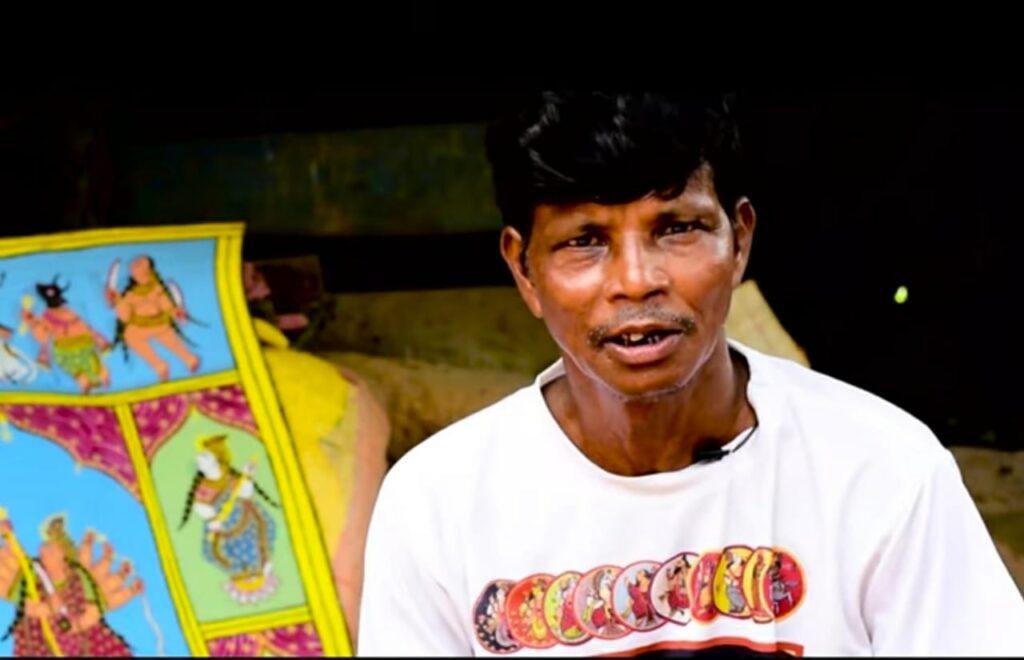
Life is like a game of cards.’– Jawaharlal Nehru
Well, apart from the philosophical perspective, a game of cards has become quite popular among people over time. It is a great means of passing time, especially during this pandemic because psst it’s an indoor game!
Did you know? The game of cards was introduced to India by the Mughals from Central Asia. These were then known as Ganjifa and consisted of 96 cards and later these Ganjifa cards were regionalised with their own set of rules and regulations and names. Like the other parts of India, Bengal also launched its own version of the Ganjifa cards called Orak that was later known as Dashavatar Tash with its increasing popularity. These were a pack of 120 cards of round shape, flawlessly hand-painted with multiple bright colours.
However, just like the fate of other regional crafts, these cards are losing the battle to cheaper paper made modern playing cards. Prashant Faujdar, who lives in Bishnupur, Bankura district of West Bengal, along with a few other members of his family is trying his best to make sure that the Dashavatara card tradition of Bishnupur doesn’t die out.
The Man Behind The Plan
The Malla kings invited skilled artisans from surrounding areas for the development of Bishnupur. Two families, each of the blacksmiths, potters, carpenters settled here. They were brought mainly from Rajasthan and were made to settle in Laugram they were given lands.

These people were later appointed to make the cards by the 49th Malla king, Bir Hambir (1565-1620), who started the Dashavatara Tash tradition here. It is said that he visited the Mughal king, Akbar’s court in Agra a few times, where he saw the game of Mughal Ganjifa cards- with 96 cards. After he came back to Bishnupur, he ordered the artists of his court to make these cards but with its own uniqueness. Bishnupur, which is regarded as a temple town, witnessed the rise of tradition of art, culture and craft with the advent of the Malla kings in 800 AD. Apart from the beautiful architecture of the temples, there are many more hidden cultural aspects in here like the Bishnupur gharana (the only musical gharana of West Bengal), the Baluchari saree and the Bishnupur silk that has a huge demand, even overseas and the Dashavatara Tash is one of them.
Gaming Rules Of The Tash
Dashavatara or the ten incarnations of Vishnu, are drawn on these cards. These incarnations are, Matsya (the fish), Kurma (the turtle), Baraha (the boar), Nrishingha (a combination of man and tiger), Baman (the dwarf), Ram (from Ramayana), Balarama (Lord Krishna’s elder brother), Parasurama (sixth incarnation with axe), Jagannatha ( face of Jagannatha with the body of Buddha) and Kalki (the destructor). These cards are a pack of 120 cards and played with several rules and regulations. The king of the game is decided depending on which avatar of Vishnu killed Asur at which time of the day. Thus the game starts with the king of ‘Ram’ during the day time, Nrisingha at twilight, Kurma during a rainy day while Matsya during a rainy night.

How Are These Made?
Surprisingly, these cards are not made of paper or board, but cloth. The first step is to prepare the glue by frying, grinding and then heating tamarind seeds. Then they take the pieces of cloth and stick it with the tamarind glue. Next they mix chalk powder with the gum and spread it over the cloth, after which they cut the cloth into circles and grind it to make it smooth and plain. Finally, they paint the avatars with bright colours. The backside of these cards are layered with lac and vermillion.
‘Belle’
This game gained a huge amount of popularity over time, but with the advent of the European printed cards in the 19th century, it declined. People were more fascinated by the European cards with attractive prints and also because these were cheaper. Even in the present day context, one pack of 120 cards are sold for Rs.30,000, while the modern machine-made cards are sold for just Rs.50 or so. According to Prashant Faujdar, even after toiling for one whole month, they are able to make only one pack of 120 cards, thus the high price. After they realised that the people are more interested in using the cards as decorative items, they started to make a pack of 10 cards with the 10 avatars of Vishnu and sell it for Rs. 3000. Slowly, all the families stopped making the cards with the declining popularity. Only the Faujdar family still continues making the cards.
After asking, why they still continue to make these cards although they hardly make a living out of it, Prashant Faujdar said, “ My forefathers have been making these cards for almost 1200 years and I take immense pride in that. This art is very close to my heart and I am trying to keep this art alive.”
The new generation doesn’t want to indulge in this because of no financial security. According to them, the government is hesitant to sustain this tradition. The Faujdars desired to start a training school, through which they could teach the youth the art of making these cards just for the sake of keeping this tradition alive, but the government did not show any interest.
Possible measures that must be taken to support the Faujdars who are trying to revive this dying tradition:
a. The governments and/or NGOs and societies should try to arrange funds for the ganjifa artists.
b. Frequent exhibitions and workshops might help to reach out to people.
c. Creating general awareness among tourists.
d. This tradition can also be documented in digital platforms to spread information.